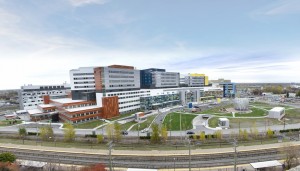 The current copy of my alumni magazine, McGill News, contains an article on the university’s new health center, a 2.5 million square-foot behemoth that consolidates no less than four existing health facilities. It’s hard to characterize this building, other than to say that it is big. The article does not identify the architect. Perhaps because this particular broth had so many cooks. The health center was built by a public-private partnership, that is, the building was designed, built, and financed by a private consortium, a process increasingly popular for public as well as private buildings. Originally, Moshe Safdie was commissioned to prepare the master plan, but he withdrew when it became apparent that the consortium, not the planner, would be calling the shots. In the event, the building appears to have been designed by at least four architectural firms. The predictable result, which a local journalist characterized as “Legoland,” exhibits no discernible architectural conviction. I recently wrote an article about Alvar Aalto’s Paimio Sanatorium, a building whose design was guided by the patients’ wellbeing. The new Montreal hospital appears to have been the result of a combination of compromise, expediency, and the bottom line. All the sadder since one of the buildings it replaces, the Royal Victoria Hospital, was a building of real architectural merit, designed by Henry Saxon Snell, a Victorian Scot who is said to have modeled his turreted limestone design on the Royal Infirmary in Edinburgh. It was built in 1893 and served for 122 years. One cook, one fine broth.
The current copy of my alumni magazine, McGill News, contains an article on the university’s new health center, a 2.5 million square-foot behemoth that consolidates no less than four existing health facilities. It’s hard to characterize this building, other than to say that it is big. The article does not identify the architect. Perhaps because this particular broth had so many cooks. The health center was built by a public-private partnership, that is, the building was designed, built, and financed by a private consortium, a process increasingly popular for public as well as private buildings. Originally, Moshe Safdie was commissioned to prepare the master plan, but he withdrew when it became apparent that the consortium, not the planner, would be calling the shots. In the event, the building appears to have been designed by at least four architectural firms. The predictable result, which a local journalist characterized as “Legoland,” exhibits no discernible architectural conviction. I recently wrote an article about Alvar Aalto’s Paimio Sanatorium, a building whose design was guided by the patients’ wellbeing. The new Montreal hospital appears to have been the result of a combination of compromise, expediency, and the bottom line. All the sadder since one of the buildings it replaces, the Royal Victoria Hospital, was a building of real architectural merit, designed by Henry Saxon Snell, a Victorian Scot who is said to have modeled his turreted limestone design on the Royal Infirmary in Edinburgh. It was built in 1893 and served for 122 years. One cook, one fine broth.
On Culture and Architecture


Great article and I completely agree that there were too many cooks on this project. I have blogged this, suggesting Bridgepoint Health in Toronto as a project where three key elements provided some insurance against mediocrity. See http://www.see-change.net/?p=1958